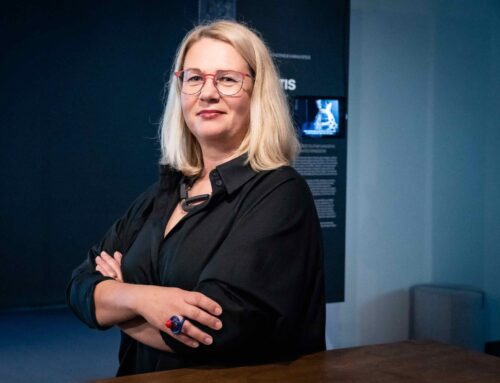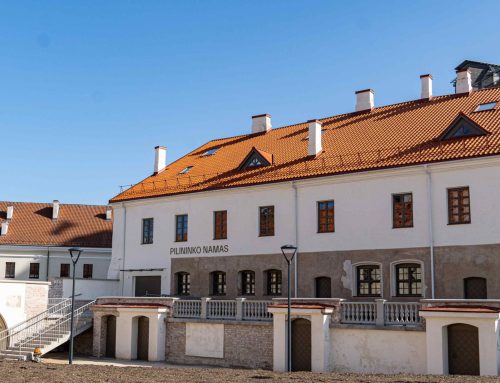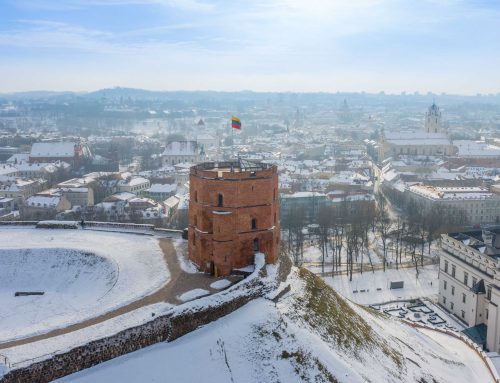Kazys Varnelis is stepping onto the world art scene: exhibition opening at the Centre Pompidou in Paris
2024 09 27
The National Museum of Lithuania is proud to present an exceptional exhibition of the works by Kazys Varnelis “Kazys Varnelis. An Optical Classicist from Lithuania.” The exhibition opens to the public at the Centre Pompidou in Paris on September 13. It features sixteen remarkable pieces by the master of op-art.
The exhibition is central to a series of opening events for the Season of Lithuania in France. The public will be able to visit the exhibition from September 14 to January 6 next year.
The art critic Indrė Urbelytė: the exhibition that captivates and enthrals
The curator of the exhibition, Indrė Urbelytė, has worked closely with Michel Gauthier, the curator of the Centre Pompidou, to select the artworks by Varnelis. Together, they have also developed the concept of the exhibition. The art critic from the Kazys Varnelis House-Museum is pleased to present Varnelis’s work to the French public. This experience offers a valuable opportunity for the curator to gain professional knowledge from French museums.
“We want exhibition visitors to feel fascinated by careful Varnelis’s brushstrokes and the shapes emerging from the canvases. When gazing at his artworks, we hope your eyes will be dazzled while a sense of solid, classical harmony lingers,” the art critic explained.
The exhibition “Kazys Varnelis. An Optical Classicist from Lithuania” at the Centre Pompidou features sixteen exceptional works by Varnelis. While he is primarily known as a unique painter, his sculptures are also on display. According to the curator, Urbelytė, efforts are being made to showcase the breadth of Varnelis’s work to a French audience, emphasising the uniqueness of his artworks not only in the Lithuanian context, but also on a global scale.
Varnelis was chosen not only for his artistic contributions but also for his life journey, which resonates deeply with many Lithuanians. He left Lithuania during the hardships of the Second World War and became an émigré in the United States of America – a fate familiar to countless Lithuanians scattered across the globe.
“Varnelis stands out not only as an artist but also as a collector. He was not an avant-gardist or a modernist in the conventional sense; he never entered the art scene with a manifesto proclaiming a desire to dismantle the established faith, system, or art, only to construct anew on its ruins. Varnelis was quite foreign to this violent, radical approach. Instead, the painter builds his work on a cultural foundation, valuing concepts of classical harmony and the chiaroscuro effect. Varnelis seeks to engage with tradition rather than deny it,” the curator of the exhibition says.
Thanks to the efforts of the National Museum of Lithuania and the artist’s son, one of Varnelis’s works has been donated to the Centre Pompidou by Jonas Dovydėnas, a Lithuanian collector based in the USA. The art critic Urbelytė has noted that valuable op-art pieces by Varnelis are a rare find in private collections, making this donation an exceptional event that enriches the collection of global significance.
Urbelytė has also pointed out that Varnelis preserved most of his artworks and later donated them to Lithuania.
“We have the majority of Varnelis’s creative legacy gathered in one place. There’s no need to search across the world to assemble Varnelis’s entire ‘gold fund’ in order to exhibit it in France – everything is here: meticulously organised, preserved, and researched. After all, there are other renowned and talented artists, both in Lithuania and among emigrants, but their scattered legacies make it difficult for their names to be recognised in the world art history in the same way. To me, this step is the first step toward including Varnelis in the global art history narrative, of which he was not a part,” the art critic reflects.
- Kazys Varnelis „Diagonal Movement (Diagonalinis judesys)“, 1972 m. Fot. Gediminas Trečiokas.
- Kazys Varnelis „Convex plus concave“, 1971 m. Fot. Gediminas Trečiokas.
- Kazys Varnelis „Azora“, 1971 m. Fot. Gediminas Trečiokas.
Rūta Kačkutė: the Season of Lithuania in France – an opportunity to establish long-term relationships
The Season of Lithuania in France is a three-month series of cultural and artistic events aimed at familiarising the French public with contemporary Lithuania.
“This season is proof of the vitality of our cultural community and our investment in the future. It presents an opportunity not only to establish strong long-term relationships with French art institutions but also to strengthen the bonds within our cultural community in Lithuania,” Chief Executive Officer Rūta Kačkutė notes.
Kačkutė has expressed her enthusiasm for collaborating with French institutions, including the Centre Pompidou in Paris and the Vasarely Foundation in Aix-en-Provence, southern France. In partnership with these institutions, the National Museum of Lithuania has prepared and published a bilingual catalogue about K. Varnelis’s works in English and French to accompany the exhibitions in France.
“The collaboration with the French, even before the official start of the Season, when creating the catalogue dedicated to Varnelis and accompanying the exhibitions, was an invaluable gift and true joy for us. The connections we’ve established and the unique publication we’ve produced will last far beyond the exhibitions themselves. The experience of communication and joint creation will endure long after the exhibitions close, and this beautiful friendship will lay the foundation for future collaborations. The book introducing Varnelis to both English- and French-speaking audiences will remain, even when the exhibitions either in Paris or in Aix-en-Provence have come to an end. In this way, the National Museum of Lithuania is also contributing to the long-term visibility of Lithuania, its history, and its artists,” Kačkutė says.
The chief executive officer of the National Museum of Lithuania has also emphasised that the opening of Varnelis’s exhibition at such a prestigious and influential art institution as the Centre Pompidou is a significant step towards integrating Lithuanian art into the global cultural canon.
“You can’t help but feel proud of this artist and eager to share him with the world – an energetic, ambitious, innovative, highly intellectual, and generous individual, deeply respectful of art traditions worldwide. His life as a war refugee and emigrant also reflects the history of our nation, as countless people were forced to flee their homeland, Lithuania,” Kačkutė observes.
Kazys Varnelis – an optical classicist from Lithuania
Kazys Varnelis (1917-2010) was an outstanding Lithuanian artist, blending op-art techniques with elements of classical art in his work. Born in Alsėdžiai, Žemaitija, Varnelis entered the world of art as a child, helping his father, Kazimieris Varnelis – a self-taught painter and a folk wood-carver of religious statues – mix paints. Later, Varnelis studied under Stasys Ušinskas at Kaunas Institute of Applied Arts. During the war, he fled to Austria, and later emigrated to the United States of America.
While attending various exhibitions in New York with his wife, Gabrielė Varnelienė, he was captivated by op-art and began to explore this direction in his own work. Varnelis’s pieces stand out for their extremely precise strokes and complex, eye-deceiving compositions, demonstrating his ability to merge tradition with modernism.
The artist’s life mirrors the experiences of countless Lithuanians – fleeing the war, settling abroad, and maintaining a connection with their homeland. After settling in Chicago, Varnelis not only continued his artistic endeavours, but also amassed a valuable art collection, which he later donated to Lithuania.
Varnelis’s oeuvre, deeply rooted in Lithuanian culture yet open to the world, now represents Lithuania on the international art stage. His works displayed at the Centre Pompidou not only recognise Lithuania’s artistic achievements but also mark a significant step in securing Varnelis’s place among world-renowned op-art artists.
The events of the National Museum of Lithuania during the Season of Lithuania in France
During the Season of Lithuania, the exhibition “Ethnographic Op-art” (curated by Indrė Urbelytė) will also open at the Vasarely Foundation, revealing the connections between Lithuanian folk art and contemporary op-art. This exhibition will feature traditional Lithuanian bedspreads alongside Varnelis’s works, with the entire exposition accompanied by music composed specially for this project by Matas Samulionis.
In addition to the exhibitions at the Centre Pompidou and the Vasarely Foundation, on October 16, the National Museum of Lithuania will organise a roundtable public discussion titled “Rethinking Identity: Museums and Heritage in the Context of War” at the Louvre, focusing on the role of museums in the times of conflict. That same week, the training programme MARTA, designed to develop museum competencies and administered by the National Museum of Lithuania, will also take place at the Louvre. The aim of the training programme is to enhance the professional skills of Lithuanian museum staff.
On September 21-22, Grenoble will host the storytelling performance The Songs of Partisan Women, where the stories of resistance from French, Lithuanian, and Ukrainian women will intertwine.
“I hope the French will see Lithuania as a creative, innovative, and united country, and pay attention to our unique, beautiful, yet challenging history. I also hope that our time with the French audience will encourage our French partners to support Ukraine during this difficult time for both Ukraine and the whole of Europe,” Kačkutė remarks on the Season of Lithuania in France.
The Season of Lithuania in France presents a unique opportunity for Lithuanian culture to showcase itself on the international stage, establish strong cultural ties with France, and share its rich history and contemporary art with the world.
- Kazys Varnelis „Oho“, 1996 m. Fot. Gediminas Trečiokas.
- Kazys Varnelis „Idiom“, 1975 m. Fot. Gediminas Trečiokas.
- Kazys Varnelis. Fot. Jonas Dovydėnas.
- Indrė Urbelytė. Fot. Silvestras Samsonas.













